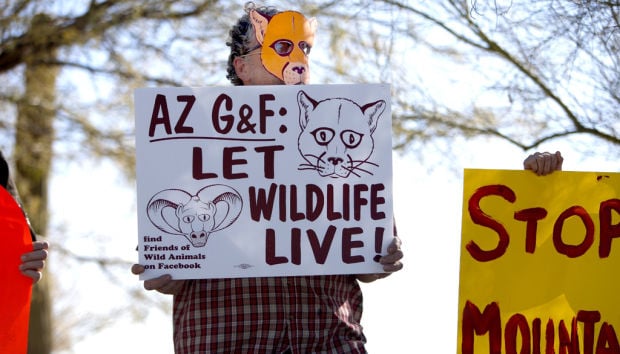A fifth bighorn sheep has died in the Catalina Mountains — the victim of a mountain lion.
Wildlife officials vowed Friday to continue the “necessary and distasteful” policy of killing lions that prey on sheep in the range north of Tucson, where 31 bighorns were reintroduced in November in an effort to re-establish a herd that died out in the 1990s.
Two mountain lions implicated in previous sheep deaths have been killed so far. Hunts for other lions, including one sought in the most recent bighorn death on Jan. 3, have been unsuccessful, officials of the Arizona Game and Fish Department reported.
Department officials and members of a citizens’ advisory committee addressed a wide range of questions about the controversial reintroduction project at a news conference.
Ben Brochu, wildlife manager for Game and Fish, said the bighorns — transplanted from mountains near Yuma — have roamed far and wide in the Catalinas since their release Nov. 18 at Catalina State Park.
Global positioning system collars indicate that sheep have spread out “from the Biosphere (2), around Pusch Ridge and east to Molino Basin,” Brochu said. “A group of four are together now” — a possible indication that the animals might begin to form a cohesive herd.
Examination of the remains of the five dead sheep indicated that “four of the sheep were killed by mountain lions, while the fifth most likely died of capture myopathy” — stemming from stress or injuries during capture, said a report released at the news conference.
PROTESTS AND QUESTIONS
Members of a recently formed group called Friends of Wild Animals turned out before the news conference with signs and statements opposing the reintroduction project and the killing of mountain lions.
“My concern is that the sheep are being wasted,” group member Ricardo Small said. “I don’t think this project will succeed for the long term.”
Another protester, Sharon Eisenhower, said, “I don’t want to see any more mountain lions get killed.”
At the conference, reporters, group members and state Sen.
Olivia Cajero Bedford pursued the controversial issue of lion killing and a perceived “secrecy” and lack of readily available information about the project.
Responding to concerns about lion killings, advisory committee member Randy Serraglio, of the Center for Biological Diversity, said he shares such concerns.
“I’m a cat person,” said Serraglio, noting that he owns a domestic cat. “It definitely pains me to think about mountain lions being killed. ... But it’s a necessary and distasteful” policy in establishing the bighorn herd.
He said the policy — in which wildlife officers establish a lion’s role by its proximity to the bighorn kill site and other factors — is “very targeted, very conservative and very limited.”
Mike Quigley, an advisory-group member with The Wilderness Society, said the group determined it probably wasn’t feasible to re-establish the herd without removing some sheep-killing lions.
“This isn’t punitive,” Quigley said. “This isn’t about punishing mountain lions for doing what mountain lions do.”
Department officials and advisory group members emphasized that female lions with kittens will not be pursued and killed even if it appears they killed a bighorn.
Cajero Bedford said she has had difficulty in getting information from the Game and Fish Department about the reintroduction project.
“There’s a feeling out there that there’s some secrecy to this project,” she said.
Advisory-group members said they sometimes need time to coordinate information and talking points, but they denied that the project is cloaked in secrecy.
“There’s nothing to hide here whatsoever,” Serraglio said.
Department officials and advisory-group members said they plan to provide written briefings on the status of the project every two weeks.





